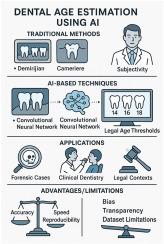人工智能在牙龄估计中的应用、技术进步和法律方面的叙述综述
Q1 Medicine
Journal of oral biology and craniofacial research
Pub Date : 2025-09-22
DOI:10.1016/j.jobcr.2025.09.010
引用次数: 0
摘要
背景牙科年龄估计是法医牙科学、儿科牙科和医学法律调查的基石。传统的射线照相方法,如Demirjian、Willems和Cameriere的方法,虽然得到了广泛的验证,但受到审查员主观性、人群特异性校准和低可扩展性的限制。本文回顾了人工智能(AI)驱动的牙齿年龄估计的现状,重点关注深度学习技术,与传统方法相比的比较优势,以及在临床、法医和法律领域的适用性。方法通过文献检索,找出利用机器学习(ML)和卷积神经网络(cnn)在全景x线片或锥束计算机断层扫描(CBCT)上估计牙齿年龄的原始研究和系统综述。重点是研究报告模型架构、平均绝对误差(MAE)、分类准确性和外部验证。结果基于人工智能的模型,特别是cnn,表现出卓越的诊断性能,MAEs范围为0.03至0.7年,在关键法律阈值下分类准确率超过90%。这些系统提供自动的牙齿检测、分割和分期,输出快速、客观、可重复。尽管如此,关键的限制仍然存在,包括算法不透明,由于非代表性训练数据集造成的人口统计学偏差,以及缺乏国际验证标准。结论人工智能技术代表了牙龄评估的范式转变,提高了准确性和操作效率。为了促进临床翻译和法医可采性,未来的工作必须优先考虑人口多样化的训练数据集、透明的算法设计和共识驱动的监管框架。本文章由计算机程序翻译,如有差异,请以英文原文为准。

Artificial intelligence in dental age estimation- applications, technological advances and legal aspects: A narrative review
Background
Dental age estimation constitutes a cornerstone in forensic odontology, pediatric dentistry, and medico-legal investigations. Traditional radiographic methods such as those by Demirjian, Willems, and Cameriere, though widely validated, are limited by examiner subjectivity, population-specific calibration, and low scalability. This narrative review examines the current landscape of artificial intelligence (AI)-driven dental age estimation, with a focus on deep learning technologies, comparative advantages over conventional methodologies, and applicability across clinical, forensic, and legal domains.
Methods
A literature search was conducted to identify original studies and systematic reviews that employed machine learning (ML) and convolutional neural networks (CNNs) for dental age estimation using panoramic radiographs or cone-beam computed tomography (CBCT). Emphasis was placed on studies reporting model architecture, mean absolute error (MAE), classification accuracy, and external validation.
Results
AI-based models, particularly CNNs, demonstrated superior diagnostic performance with MAEs ranging from 0.03 to 0.7 years and classification accuracies exceeding 90 % at critical legal thresholds. These systems provide automated tooth detection, segmentation, and staging, with outputs that are rapid, objective, and reproducible. Nonetheless, critical limitations persist, including algorithmic opacity, demographic bias due to non-representative training datasets, and absence of international validation standards.
Conclusion
AI technologies represent a paradigm shift in dental age estimation, offering enhanced precision and operational efficiency. To facilitate clinical translation and forensic admissibility, future efforts must prioritize population-diverse training datasets, transparent algorithmic design, and consensus-driven regulatory frameworks.
求助全文
通过发布文献求助,成功后即可免费获取论文全文。
去求助
来源期刊

Journal of oral biology and craniofacial research
Medicine-Otorhinolaryngology
CiteScore
4.90
自引率
0.00%
发文量
133
审稿时长
167 days
期刊介绍:
Journal of Oral Biology and Craniofacial Research (JOBCR)is the official journal of the Craniofacial Research Foundation (CRF). The journal aims to provide a common platform for both clinical and translational research and to promote interdisciplinary sciences in craniofacial region. JOBCR publishes content that includes diseases, injuries and defects in the head, neck, face, jaws and the hard and soft tissues of the mouth and jaws and face region; diagnosis and medical management of diseases specific to the orofacial tissues and of oral manifestations of systemic diseases; studies on identifying populations at risk of oral disease or in need of specific care, and comparing regional, environmental, social, and access similarities and differences in dental care between populations; diseases of the mouth and related structures like salivary glands, temporomandibular joints, facial muscles and perioral skin; biomedical engineering, tissue engineering and stem cells. The journal publishes reviews, commentaries, peer-reviewed original research articles, short communication, and case reports.
 求助内容:
求助内容: 应助结果提醒方式:
应助结果提醒方式:


